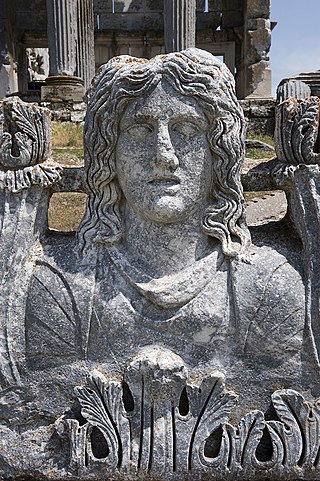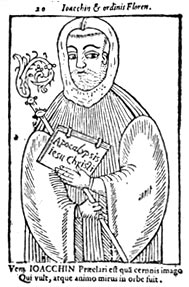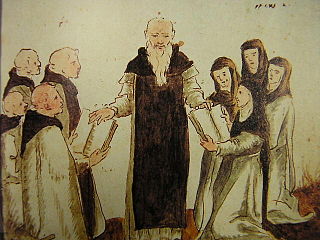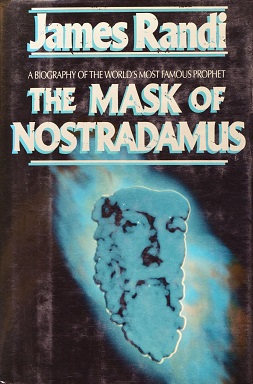
Michel de Nostredame, usually Latinised as Nostradamus, was a French astrologer, apothecary, physician, and reputed seer, who is best known for his book Les Prophéties, a collection of 942 poetic quatrains allegedly predicting future events.

A psychic is a person who claims to use powers rooted in parapsychology such as extrasensory perception (ESP) to identify information hidden from the normal senses, particularly involving telepathy or clairvoyance, or who performs acts that are apparently inexplicable by natural laws, such as psychokinesis or teleportation. Although many people believe in psychic abilities, the scientific consensus is that there is no proof of the existence of such powers, and describes the practice as pseudoscience. The word "psychic" is also used as an adjective to describe such abilities.

In religion, a prophecy is a message that has been communicated to a person by a supernatural entity. Prophecies are a feature of many cultures and belief systems and usually contain divine will or law, or preternatural knowledge, for example of future events. They can be revealed to the prophet in various ways depending on the religion and the story, such as visions, divination, or direct interaction with divine beings in physical form. Stories of prophetic deeds sometimes receive considerable attention and some have been known to survive for centuries through oral tradition or as religious texts.

The sibyls were prophetesses or oracles in Ancient Greece.

The Sibylline Oracles are a collection of oracular utterances written in Greek hexameters ascribed to the Sibyls, prophetesses who uttered divine revelations in a frenzied state. Fourteen books and eight fragments of Sibylline Oracles survive, in an edition of the 6th or 7th century AD. They are not to be confused with the original Sibylline Books of the ancient Etruscans and Romans which were burned by order of the Roman general Flavius Stilicho in the 4th century AD. Instead, the text is an "odd pastiche" of Hellenistic and Roman mythology interspersed with Jewish, Gnostic and early Christian legend.

The Sibylline Books were a collection of oracular utterances, set out in Greek hexameter verses, that, according to tradition, were purchased from a sibyl by the last king of Rome, Lucius Tarquinius Superbus, and consulted at momentous crises through the history of the Roman Republic and the Empire.

Joachim of Fiore, also known as Joachim of Flora, was an Italian Christian theologian, Catholic abbot, and the founder of the monastic order of San Giovanni in Fiore. According to theologian Bernard McGinn, "Joachim of Fiore is the most important apocalyptic thinker of the whole medieval period." The Divine Comedy of Dante Alighieri is one of the most famous works possibly inspired by his ideas.
Postdiction involves explanation after the fact. In skepticism, it is considered an effect of hindsight bias that explains claimed predictions of significant events such as plane crashes and natural disasters. In religious contexts, theologians frequently refer to postdiction using the Latin term vaticinium ex eventu. Through this term, skeptics postulate that many biblical prophecies appearing to have come true may have been written after the events supposedly predicted, or that the text or interpretation may have been modified after the event to fit the facts as they occurred.

The Man Who Saw Tomorrow is a 1981 documentary-style movie about the predictions of French astrologer and physician Michel de Notredame (Nostradamus).

The Vaticinia Michaelis Nostradami de Futuri Christi Vicarii ad Cesarem Filium D. I. A. Interprete, or Vaticinia Nostradami for short, is a collection of eighty watercolor images compiled as an illustrated codex. A version of the well-known Vaticinia de Summis Pontificibus of the 13th–14th century, it was discovered in 1994 by the Italian journalists Enza Massa and Roberto Pinotti in the Biblioteca Nazionale Centrale di Roma in Rome, Italy. The document can be found in the library under the title Fondo Vittorio Emanuele 307.

The prophecies of the 16th-century author Nostradamus have become a part of the popular culture of the 20th and 21st centuries. Nostradamus' life has been depicted in both fiction and non-fiction books as well as several films, and made-up prophecies that were said to be his were circulated online in several well-known hoaxes, where quatrains in the style of Nostradamus have been circulated by e-mail. The most well-known hoax claims that he predicted the attack on New York City's World Trade Center on September 11, 2001.

Les Prophéties is a collection of prophecies by French physician Nostradamus, the first edition of which appeared in 1555 by the publishing house Macé Bonhomme. His most famous work is a collection of poems, quatrains, united in ten sets of verses ("Centuries") of 100 quatrains each.

The Mask of Nostradamus: The Prophecies of the World's Most Famous Seer is a 1990 book by magician and skeptic James Randi. Randi provides an overview of the life and work of Nostradamus, a 16th-century French physician and astrologer who, in a series of quatrains in Les Prophéties, allegedly predicted several major historical events. Randi argues that Nostradamus was actually an exceptionally poor prognosticator who used vague and ambiguous language to give an illusion of authenticity. Randi further describes the widespread use of poor scholarship, mistranslations, and reference to forged prophecies by Nostradamus’s believers, and describes dubious methods that believers have used to obtain meaning from Nostradamus’s prophecies. Randi also provides an overview of the popularity and pseudoscientific nature of astrology, a technique that Nostradamus used to prepare prophecies, as well as providing an overview of other prophets and their methods. The book received generally positive reviews.

Renaissance magic was a resurgence in Hermeticism and Neo-Platonic varieties of the magical arts which arose along with Renaissance humanism in the 15th and 16th centuries CE. During the Renaissance period, magic and occult practices underwent significant changes that reflected shifts in cultural, intellectual, and religious perspectives. C. S. Lewis, in his work on English literature, highlighted the transformation in how magic was perceived and portrayed. In medieval stories, magic had a fantastical and fairy-like quality, while in the Renaissance, it became more complex and tied to the idea of hidden knowledge that could be explored through books and rituals. This change is evident in the works of authors like Spenser, Marlowe, Chapman, and Shakespeare, who treated magic as a serious and potentially dangerous pursuit.
Last Roman Emperor, also called Last World Emperor or Emperor of the Last Days, is a figure of medieval European legend, which developed as an aspect of Christian eschatology. The legend predicts that in the end times, a last emperor would appear on earth to reestablish the Roman Empire and assume his function as biblical katechon who stalls the coming of the Antichrist. The legend first appears in the 7th-century apocalyptic text known as the Apocalypse of Pseudo-Methodius; that and the oracles of the Tiburtine Sibyl are its two most important sources. It developed over the centuries, becoming particularly prominent in the 15th century. The notion of Great Catholic Monarch is related to it.
Telesphorus of Cosenza was a name assumed by one of the pseudo-prophets during the time of the Western Schism. As an pseudonymous author of a Latin work Liber de magnis tribulationibus, the name was attached to a 1365 production of the Fraticelli. The Liber was updated to fit the situation in the Schism.

Nostradamus Effect is an American television series that premiered on September 9, 2009, on the History channel. The program detailed various historical apocalyptic prophecies, such as the 2012 phenomenon. The show was named after reputed French seer Michel de Nostredame, more commonly known as Nostradamus. The series ran for a single season.

The Cumaean Sibyl was the priestess presiding over the Apollonian oracle at Cumae, a Greek colony near Naples, Italy. The word sibyl comes from the ancient Greek word sibylla, meaning prophetess. There were many sibyls throughout the ancient world. Because of the importance of the Cumaean Sibyl in the legends of early Rome as codified in Virgil's Aeneid VI, and because of her proximity to Rome, the Cumaean Sibyl became the most famous among the Romans. The Erythraean Sibyl from modern-day Turkey was famed among Greeks, as was the oldest Hellenic oracle, the Sibyl of Dodona, dating to the second millennium BC according to Herodotus, favored in the east.

The Fiore di virtù is an anonymous Italian prose treatise on morality from the first half of the 14th century. It was a popular and widely translated work into the 16th century.